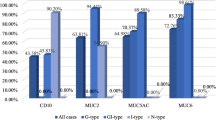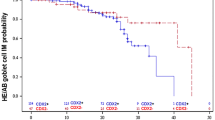Abstract
Purpose
Several studies performed on pancreatic-duodenal homeobox 1 (PDX1) have demonstrated a loss of expression and negative tumor modulator effect in gastric carcinoma. Relations between PDX1 and gastric metaplasia, differentiated type of gastric carcinoma, and the early stage of the disease have been exhibited in previous reports. The aim of this study was to examine expressions of PDX1, caudal type homeobox 2 (CDX2) and mucin (MUC) profiles to address the role of PDX1 in gastric carcinogenesis and its relationship with CDX2.
Methods
Seventy gastrectomy specimens were analyzed immunohistochemically for PDX1, CDX2, MUC2, MUC5AC, and MUC6 expressions. The sum of cytoplasmic and nuclear PDX1 immunostaining and PDX1 positivity were assessed. All of the antibodies were examined for a correlation with tumor type, clinicopathologic parameters, and metaplasias. The relation of Ki-67 proliferation index with the expression profiles was also investigated.
Results
Neither PDX1 (66/70) nor CDX2 (37/70) and the mucin profiles (MUC2:11/70, MUC5AC:48/70, MUC6:41/70) showed a significant difference between differentiated and undifferentiated types of gastric carcinoma and clinicopathologic parameters. The PDX1 expression frequency was 94.3%, with an average PDX1 score of 8.8 ± 4.2. PDX1 and CDX2 expression showed a significant difference (P = 0.026 and P = 0.002, respectively) among the phenotypic classification of gastric carcinomas. All of the gastric and intestinal mixed-phenotype gastric carcinomas (GI-type) showed both PDX1 and CDX2 immunopositivity. Except for the relation of PDX1 score with MUC6 expression, no significant difference was detected between PDX1 and CDX2, MUC2, and MUC5AC expressions. A relationship between CDX2 and MUC2 and also between MUC5AC and MUC6 was found statistically. The Ki-67 proliferation index revealed a significant positive correlation with PDX1, CDX2, and MUC2 positivity.
Conclusions
PDX1 expression revealed a higher positivity in gastric carcinomas than the previous studies and showed no relation with tumor type, clinicopathologic parameters, CDX2 expression, or mucin profiles. However, a significant relation of PDX1 and CDX2 expressions among phenotypic classification of gastric carcinomas reveals an idea about similar functions for PDX1 and CDX2 in the evolution of gastric carcinoma.






Similar content being viewed by others
References
Akyürek N, Akyol G, Dursun A et al (2002) Expression of MUC1 and MUC2 mucins in gastric carcinomas: their relationship with clinicopathologic parameters and prognosis. Pathol Res Pract 198(10):665–674
Alappat S, Zhang ZY, Chen YP (2003) Msx homeobox gene family and craniofacial development. Cell Res 13:429–442
Almeida R, Silva E, Santos-Silva F et al (2003) Expression of intestine-specific transcription factors, CDX1 and CDX2, in intestinal metaplasia and gastric carcinomas. J Pathol 199:36–40
Bai Y, Akiyama Y, Nagasaki H et al (2000) Distinct expression of CDX2 and GATA4/5, development-related genes in human gastric cancer cell lines. Mol Carcinog 28(3):184–188
Bai YQ, Yamamoto H, Akiyama Y et al (2002) Ectopic expression of homeodomain protein CDX2 in intestinal metaplasia and carcinomas of the stomach. Cancer Lett 176:47–55
Barresi V, Vitarelli E, Grosso M, Tuccari G, Barresi G (2006) Relationship between immunoexpression of mucin peptide cores MUC1 and MUC2 and Lauren’s histologic subtypes of gastric carcinomas. Eur J Histochem 50(4):301–309
Barros R, da Costa LT, Pinto-de-Sousa J et al (2011) CDX2 autoregulation in human intestinal metaplasia of the stomach: impact on the stability of the phenotype. Gut 60(3):290–298
Brooke NM, Garcia-Fernandez J, Holland PW (1998) The ParaHox gene cluster is an evolutionary sister of the Hox gene cluster. Nature 392:920–922
Buettner M, Dimmler A, Magener A et al (2004) Gastric PDX-1 expression in pancreatic metaplasia and endocrine cell hyperplasia in atrophic corpus gastritis. Mod Pathol 17:56–61
Carrato C, Balague C, Bolos C et al (1994) Differential apomucin expression in normal and neoplastic human gastrointestinal tissues. Gastroenterology 107:160–172
Chiba T (2002) Key molecules in metaplastic gastritis: sequential analysis of CDX1/2 homeobox gene expression. J Gastroenterol 37:94–100
Cole AG, Rizzo F, Martinez P, Fernandez-Serra M, Arnone MI (2009) Two ParaHox genes, SpLox and SpCdx, interact to partition the posterior endoderm in the formation of a functional gut. Development 136(4):541–549
Correa P (1992) Human gastric carcinogenesis: a multistep and multifactorial process. First American cancer society award lecture on cancer epidemiology and prevention. Cancer Res 52:6735–6740
de Vries AC, van Grieken NC, Looman CW et al (2008) Gastric cancer risk in patients with premalignant gastric lesions: a nationwide cohort study in the Netherlands. Gastroenterology 134:945–952
Fenoglio-Preiser C, Mun˜oz N, Carneiro F et al (2000) Gastric carcinoma. In: Hamilton SR, Aaltonen LA (eds) World Health Organization classification of tumours. Pathology and genetics of tumours of the digestive system. IARC Press, Lyon, pp 39–52
Goldenring JR, Nam KT (2010) Oxyntic atrophy, metaplasia, and gastric cancer. Prog Mol Biol Transl Sci 96:117–131
Goldenring JR, Nomura S (2006) Differentiation of the gastric mucosa III. Animal models of oxyntic atrophy and metaplasia. Am J Physiol Gastointest Liver Physiol 291:999–1004
Goldenring JR, Nam KT, Wang TC, Mills JC, Wright NA (2010) Spasmolytic polypeptide-expressing metaplasia and intestinal metaplasia: time for reevaluation of metaplasias and the origins of gastric cancer. Gastroenterology 138(7):2207–10, 2210.e1
Grainger S, Savory JG, Lohnes D (2010) Cdx2 regulates patterning of the intestinal epithelium. Dev Biol 339(1):155–165
Guarner J, Mohar A, Parsonnet J et al (1993) The association of helicobacter pylori with gastric cancer and preneoplastic gastric lesions in Chiapas, Mexico. Cancer 71:297–301
Hassan NM, Hamada J, Murai T et al (2006) Aberrant expression of HOX genes in oral dysplasia and squamous cell carcinoma tissues. Oncol Res 16:217–224
Ho SB, Shekels LL, Toribara NW et al (1995) Mucin gene expression in normal, preneoplastic, and neoplastic human gastric epithelium. Cancer Res 55:2681–2690
İlhan Ö, Han Ü, Önal B, Çelik SY (2010) Prognostic significance of MUC1, MUC2 and MUC5AC expressions in gastric carcinoma. Turk J Gastroenterol 21(4):345–352
Japanese Gastric Cancer Association (1998) Japanese classification of gastric carcinoma. 2nd English edn. Gastric Cancer 1:10–24
Laurén P (1965) The two histological main types of gastric carcinoma: Diffuse and so-called intestinal-type carcinoma. An attempt at a histo-clinical classification. Acta Pathol Microbiol Scand 64:31–49
Lee HS, Lee HK, Kim HS et al (2001) MUC1, MUC2, MUC5AC, and MUC6 expressions in gastric carcinomas: their roles as prognostic indicators. Cancer 92(6):1427–1434
Leteurtre E, Zerimech F, Piessen G et al (2006) Relationships between mucinous gastric carcinoma, MUC2 expression and survival. World J Gastroenterol 12(21):3324–3331
Leys CM, Nomura S, Rudzinski E et al (2006) Expression of Pdx-1 in human gastric metaplasia and gastric adenocarcinoma. Hum Pathol 37(9):1162–1168
Liu Q, Teh M, Ito K et al (2007) CDX2 expression is progressively decreased in human gastric intestinal metaplasia, dysplasia and cancer. Mod Pathol 20(12):1286–1297
Ma J, Chen M, Wang J et al (2008) Pancreatic duodenal homeobox-1 (PDX1) functions as a tumor suppressor in gastric cancer. Carcinogenesis 29:1327–1333
Machado JC, Nogueira AM, Carneiro F et al (2000) Gastric carcinoma exhibits distinct types of cell differentiation: an immunohistochemical study of trefoil peptides (TFF1 and TFF2) and mucins (MUC1, MUC2, MUC5AC, and MUC6). J Pathol 190:437–443
Melton DA (1991) Pattern formation during animal development. Science 252:234–241
Mizoshita T, Tsukamoto T, Nakanishi H et al (2003) Expression of Cdx2 and the phenotype of advanced gastric cancers: Relationship with prognosis. J Cancer Res Clin Oncol 129:727–734
Mizoshita T, Tsukamoto T, Tanaka H et al (2005) Colonic and small-intestinal phenotypes in gastric cancers: relationships with clinicopathological findings. Pathol Int 55(10):611–618
Mortlock DP, Innis JW (1997) Mutation of HOXA13 in hand-foot-genital syndrome. Nat Genet 15:179–180
Mutoh H, Sakurai S, Satoh K et al (2004) Development of gastric carcinoma from intestinal metaplasia in Cdx2- transgenic mice. Cancer Res 64:7740–7747
Nam KT, Lee HJ, Mok H, Romero-Gallo J, Crowe JE Jr, Peek RM Jr, Goldenring JR (2009) Amphiregulin-deficient mice develop spasmolytic polypeptide expressing metaplasia and intestinal metaplasia. Gastroenterology 136(4):1288–1296
Naora H, Yang YQ, Montz FJ et al (2001) A serologically identified tumor antigen encoded by a homeobox gene promotes growth of ovarian epithelial cells. Proc Natl Acad Sci USA 98:4060–4065
Nogueira AM, Machado JC, Carneiro F et al (1999) Patterns of expression of trefoil peptides and mucins in gastric polyps with and without malignant transformation. J Pathol 187:541–548
Offield MF, Jetton TL, Labosky PA et al (1996) PDX-1 is required for pancreatic outgrowth and differentiation of the rostral duodenum. Development 122:983–995
Pitera JE, Smith VV, Thorogood P, Milla PJ (1999) Coordinated expression of 3’ Hox genes during murine embryonal gut development: an enteric Hox code. Gastroenterology 117:1339–1351
Sakai H, Eishi Y, Li XL et al (2004) PDX1 homeobox protein expression in pseudopyloric glands and gastric carcinomas. Gut 53:323–330
Schmidt PH, Lee JR, Joshi V et al (1999) Identification of a metaplastic cell lineage associated with human gastric adenocarcinoma. Lab Invest 79:639–646
Scott MP, Tamkun JW, Hartzell GW (1989) The structure and function of the homeodomain. Biochim Biophys Acta 989:25–48
Seno H, Oshima M, Taniguchi MA et al (2002) CDX2 expression in the stomach with intestinal metaplasia and intestinal-type cancer: Prognostic implications. Int J Oncol 21(4):769–774
Silberg DG, Swain GP, Suh ER et al (2000) Cdx1 and Cdx2 expression during intestinal development. Gastroenterology 119:961–971
Stoffers DA, Heller RS, Miller CP et al (1999) Developmental expression of the homeodomain protein IDX-1 in mice transgenic for an IDX-1 promoter/lacZ transcriptional reporter. Endocrinology 140:5374–5381
Tajima Y, Shimoda T, Nakanishi Y et al (2001) Gastric and intestinal phenotypic marker expression in gastric carcinomas and its prognostic significance: immunohistochemical analysis of 136 lesions. Oncology 61:212–220
Tatematsu M, Tsukamoto T, Inada K (2003) Stem cells and gastric cancer: role of gastric and intestinal mixed intestinal metaplasia. Cancer Sci 94:135–141
Tsukamoto T, Mizoshita T, Tatematsu M (2006) Gastric-and-intestinal mixed-type intestinal metaplasia: aberrant expression of transcription factors and stem cell intestinalization. Gastric Cancer 9:156–166
Uemura N, Okamoto S, Yamamoto S et al (2001) Helicobacter pylori infection and the development of gastric cancer. N Engl J Med 345:784–789
Wang XP, Li ZJ, Magnusson J, Brunicardi FC (2005) Tissue Micro Array analyses of pancreatic duodenal homeobox-1 in human cancers. World J Surg 29(3):334–338
Weis VG, Goldenring JR (2009) Current understanding of SPEM and its standing in the preneoplastic process. Gastric Cancer 12(4):189–197
Yamamoto H, Bai YQ, Yuasa Y (2003) Homeodomain protein CDX2 regulates goblet-specific MUC2 gene expression. Biochem Biophys Res Commun 300(4):813–818
Yoshizawa N, Takenaka Y, Yamaguchi Y, Tetsuya T, Tanaka H, Tatematsu M, Nomura S, Goldenring JR, Kaminishi M (2007) Emergence of spasmolytic polypeptide-expressing metaplasia in Mongolian gerbils infected with Helicobacter pylori. Lab Invest 87:1265–1276
Yuasa Y (2003) Control of gut differentiation and intestinal-type gastric carcinogenesis. Nat Rev Cancer 3:592–600
Zhu S, Xia HH, Yang Y et al (2009) Alterations of gastric homeoprotein expression in Helicobacter pylori infection, incisural antralisation, and intestinal metaplasia. Dig Dis Sci 54(5):996–1002
Conflict of interest
Fulya Oz Puyan certify that no actual or potential conflict of interest in relation to this artical exists.
Author information
Authors and Affiliations
Corresponding author
Rights and permissions
About this article
Cite this article
Oz Puyan, F., Can, N., Ozyilmaz, F. et al. The relationship among PDX1, CDX2, and mucin profiles in gastric carcinomas; correlations with clinicopathologic parameters. J Cancer Res Clin Oncol 137, 1749–1762 (2011). https://doi.org/10.1007/s00432-011-1044-7
Received:
Accepted:
Published:
Issue Date:
DOI: https://doi.org/10.1007/s00432-011-1044-7




